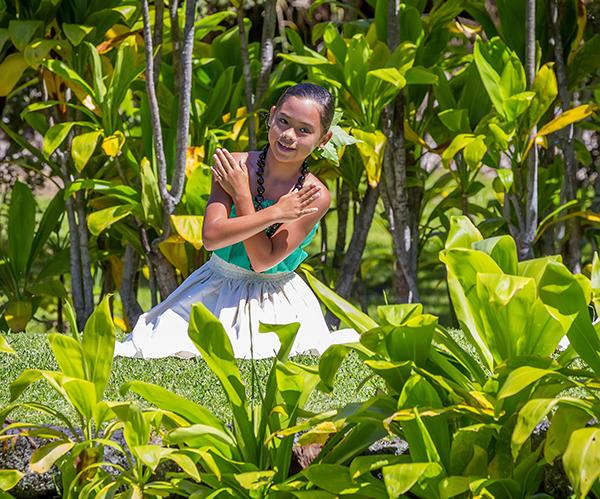
The flowing movement of traditional hula performed by Kalamanamana Harman and accompanied by Pelehonuamea Harman, Hawai'i Volcanoes National Park /Rebecca Latson.
Aloha.
As I stood near the Kahua Hula (dance platform) inside Hawai'i Volcanoes National Park, waiting for the hula demonstration to begin, an epiphany dawned upon me that photography in a national park (or national monument or national landmark or national historical site) is not always about the wide-angle landscapes or the close-up wildlife portraits.
Sometimes, photography in a national park (or national monument or national landmark or national historical site) is about the culture, the people, and the history. Those of you who have visited places such as Morristown National Historical Park or the Fort Union Trading Post National Historical Site or Gettysburg National Military Park already know that. For this gal, however, it was a new photographic angle.
My plane didn't depart from Hilo until late that night, so I figured I could remain within the park for much of the day. I didn't want to go for a long hike because everything was packed away and I wouldn't have access to a shower to clean up afterwards. Still trying to figure out my game plan, I wanderd into the Volcano Art Center (located next door to the national park's Kilauea Visitor Center) and happily proceeded to support the local artisans and economy (i.e. I spent money).
While in the Volcano Art Center, I noticed a flyer announcing the hula demonstration that day. I definitely could make time for that, and I might get some really cool photos (I'm always thinking of future photography columns for the Traveler, you know). I had a hunch this demonstration would not be the glitzy, fast-moving kind accompanied by a ukulele that may initially come to mind, but instead would be the graceful and serene movement imbued with tradition and love of the land, accompanied by traditional chant (mele).

Kekoa and Pelehonuamea Harman on the Kahua Hula, Hawai'i Volcanoes National Park / Rebecca Latson.
That day's dancing would be performed by students from the Nawahiokalaniopu`u Hawaiian Immersion Public Charter School under the direction of Kekoa and Pelehonuamea Harman, founders of the Hula School of the Living Voices of the Descendants (HÄlau I Ka Leo Ola O NÄ Mamo). The Harmans started the hÄlau (school) six years ago with the purpose of preserving traditional Hawaiian song and dance through the medium of the Hawaiian language. Because the students attend a Hawaiian language immersion school, most of them are fluent or in the process of becoming fluent in the language. The Harmans believe teaching hula and mele in the Hawaiian language encourages their students to better understand not only the meaning of each song to which they dance but also the nuances of the language itself.
The grassy area surrounding the Kahua Hula began to fill mostly with the families of the dancers but also with visitors such as myself. Since I did not wish to block the view of the audience nor call attention away from the performance, I kept to the rear of the area and used my 70-200mm lens. I set the focus to 'servo mode,' allowing me to lock in on my moving subjects for a clear image capture. While it was a beautiful, clear, sunny day in the park, I still set my ISO to 640 in order to use a fast shutter speed to better freeze the movement.

Pelehonuamea Harman performing traditional mele (chant) accompaniment / Rebecca Latson.
The thing to remember when photographing performances such as this, particularly if your intention is to use the images in a story for an entity such as the Traveler, is that it's important to introduce yourself to the person/people in charge, inform them of what you wish to do, try to learn a little bit about the performers and (very importantly) get permission from the proper entity to use any photos for a publication. It's not only a good business practice, but also just plain courteous as well.
Hawai'i truly is a paradise; I have never felt so relaxed and stress-free as I did during my too-short stay there. Hawai'i Volcanoes National Park is an amazing place with a diverse ecosystem and some really neat geology. Where else can you stay in a hotel on the edge of a caldera, or set your tripod and camera up at night at one of several awesome view areas to capture the brilliant, steaming orange glow billowing forth from Kilauea with the stars overhead, or listen to traditional Hawaiian mele while watching (and photographing) a hula dancer trace a flowing story of the land and its people?

Student Kaiulani Young performing on the Kahua Hula, Hawai'i Volcanoes National Park / Rebecca Latson.
A very special mahalo (thank you) to Kekoa and Pelehonuamea Harman for granting permission for the use of the photos in this article, giving me the names of the dancers, and providing information about their hÄlau. Mahalo also to Desiree Cruz of the Volcano Art Center Hula Program, who furnished information about that particular day's dance performance and was instrumental in introducing me to the Harmans.









Add comment